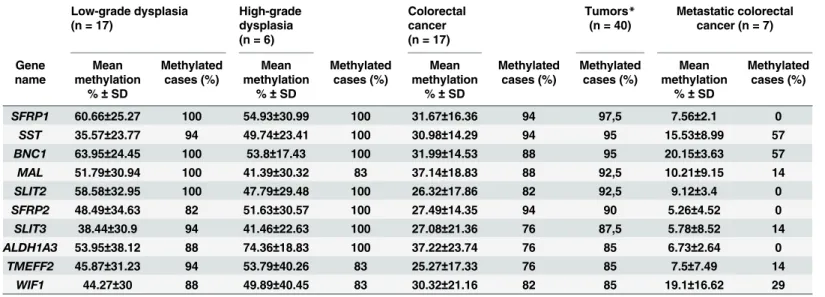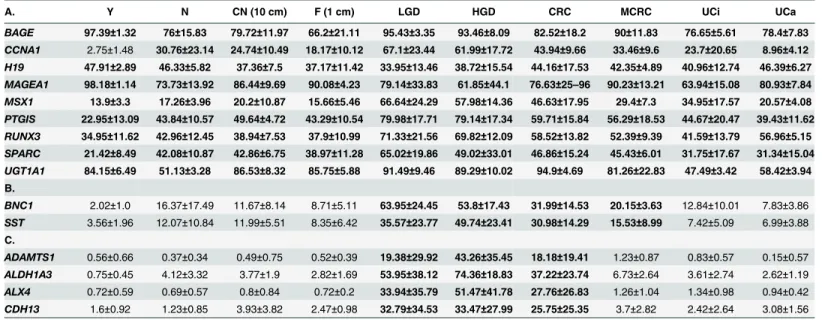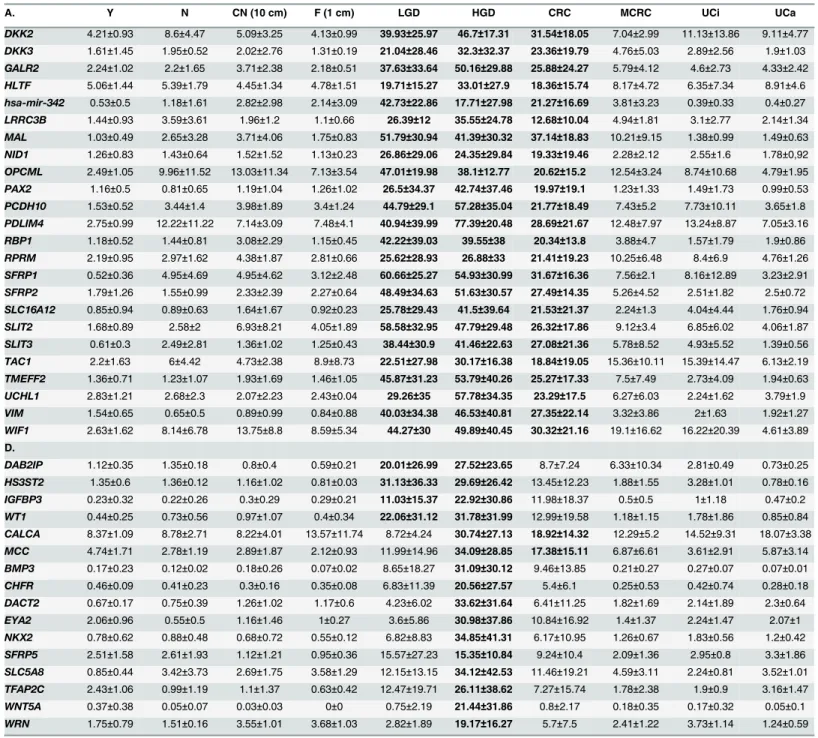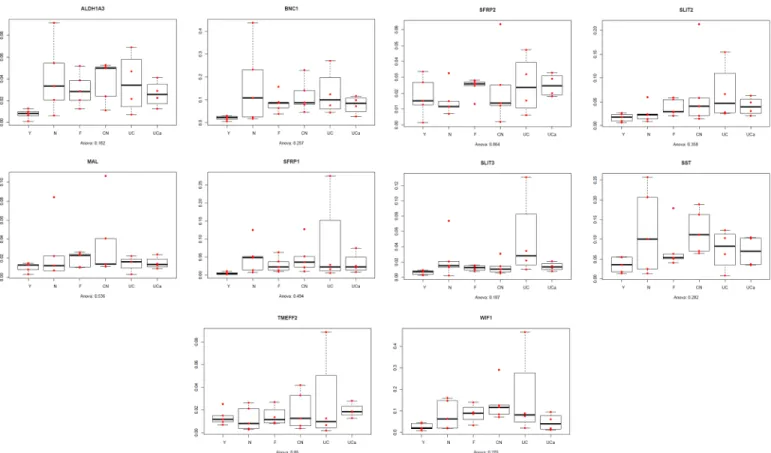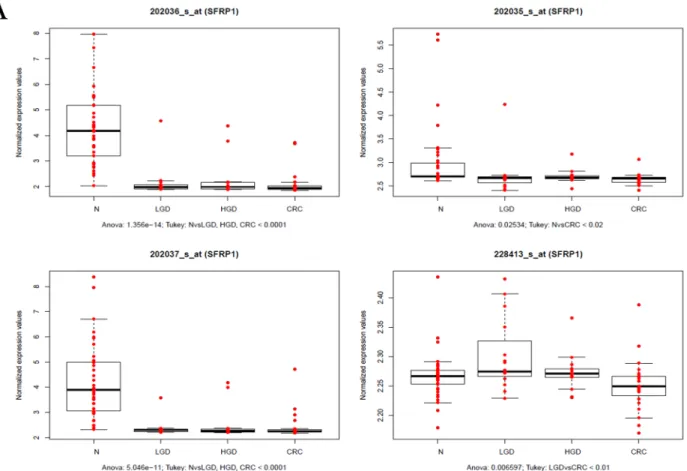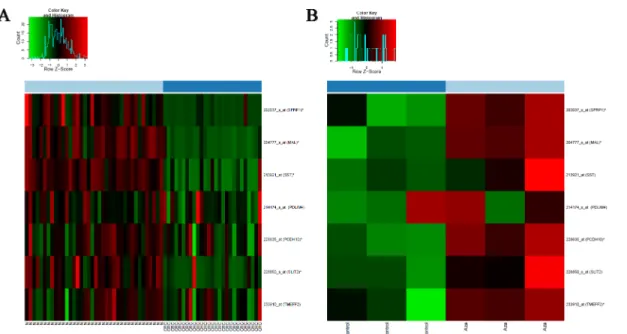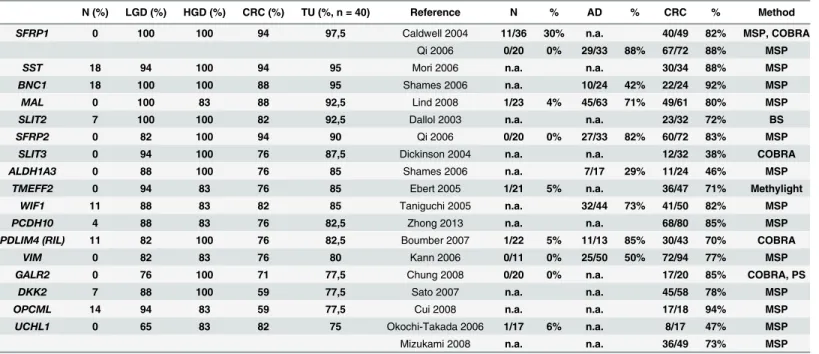Comprehensive DNA Methylation Analysis Reveals a Common Ten-Gene Methylation Signature in Colorectal Adenomas and Carcinomas
Árpád V. Patai1*, Gábor Valcz2, Péter Hollósi3,4, Alexandra Kalmár1, Bálint Péterfia2, Árpád Patai5, Barnabás Wichmann2, Sándor Spisák2,6, Barbara Kinga Barták1, Katalin Leiszter1, Kinga Tóth1, Ferenc Sipos1, Ilona Kovalszky3, Zoltán Péter1, Pál Miheller1, Zsolt Tulassay1,2, Béla Molnár1,2
12nd Department of Medicine, Semmelweis University, Budapest, Hungary,2Molecular Medicine Research Group, Hungarian Academy of Sciences, Budapest, Hungary,31st Department of Pathology and Experimental Cancer Research, Semmelweis University, Budapest, Hungary,4Tumor Progression Research Group, Hungarian Academy of Sciences, Budapest, Hungary,5Department of Gastroenterology and Medicine, Markusovszky University Teaching Hospital, Szombathely, Hungary,6Dana-Farber Cancer Institute, Harvard Medical School, Boston, Massachusetts, United States of America
*arpad.patai@gmail.com
Abstract
Microarray analysis of promoter hypermethylation provides insight into the role and extent of DNA methylation in the development of colorectal cancer (CRC) and may be co-moni- tored with the appearance of driver mutations. Colonic biopsy samples were obtained endoscopically from 10 normal, 23 adenoma (17 low-grade (LGD) and 6 high-grade dys- plasia (HGD)), and 8 ulcerative colitis (UC) patients (4 active and 4 inactive). CRC sam- ples were obtained from 24 patients (17 primary, 7 metastatic (MCRC)), 7 of them with synchronous LGD. Field effects were analyzed in tissues 1 cm (n = 5) and 10 cm (n = 5) from the margin of CRC. Tissue materials were studied for DNA methylation status using a 96 gene panel and forKRASandBRAFmutations. Expression levels were assayed using whole genomic mRNA arrays. SFRP1 was further examined by immunohistochem- istry. HT29 cells were treated with 5-aza-2’deoxycytidine to analyze the reversal possibil- ity of DNA methylation. More than 85% of tumor samples showed hypermethylation in 10 genes (SFRP1,SST,BNC1,MAL,SLIT2,SFRP2,SLIT3,ALDH1A3,TMEFF2,WIF1), whereas the frequency of examined mutations were below 25%. These genes distin- guished precancerous and cancerous lesions from inflamed and healthy tissue. The mRNA alterations that might be caused by systematic methylation could be partly reversed by demethylation treatment. Systematic changes in methylation patterns were observed early in CRC carcinogenesis, occuring in precursor lesions and CRC. Thus we conclude that DNA hypermethylation is an early and systematic event in colorectal carci- nogenesis, and it could be potentially reversed by systematic demethylation therapy, but it would need more in vitro and in vivo experiments to support this theory.
OPEN ACCESS
Citation:Patai ÁV, Valcz G, Hollósi P, Kalmár A, Péterfia B, Patai Á, et al. (2015) Comprehensive DNA Methylation Analysis Reveals a Common Ten-Gene Methylation Signature in Colorectal Adenomas and Carcinomas. PLoS ONE 10(8): e0133836.
doi:10.1371/journal.pone.0133836
Editor:Ken Mills, Queen's University Belfast, UNITED KINGDOM
Received:February 12, 2015 Accepted:July 2, 2015 Published:August 20, 2015
Copyright:© 2015 Patai et al. This is an open access article distributed under the terms of the Creative Commons Attribution License, which permits unrestricted use, distribution, and reproduction in any medium, provided the original author and source are credited.
Data Availability Statement:The authors confirm that all data underlying the findings are fully available without restriction. All .cel files are available at GEO (Gene Expression Omnibus,http://www.ncbi.nlm.nih.
gov/geo/) under access numbers: GSE4183, GSE10714, GSE15960, GSE29060 and GSE37364.
Funding:This study was supported by the National Office for Research and Technology, Hungary, (Grant number: TECH_08-A1/2-2008-0114) and by the Hungarian Scientific Research Fund (OTKA, Grant number: K 111743,www.magzrt.huandwww.otka.
hu). The funders had no role in study design, data
Background
Colorectal cancer (CRC) is a clinically and molecularly heterogenous disease [1]. With over 1.2 million new cases annually, it is one of the most frequently occurring malignant diseases world- wide [2]. Despite considerable advances in the management of CRC, over 600,000 CRC-related deaths occur annually [2], reflecting a clear need for a better understanding of the disease.
The majority of CRCs arise via the adenoma-carcinoma sequence (ACS), which is thought to be driven by sequential accumulation of genetic mutations [3]. Recent whole genome sequencing studies confirmed the early findings that mutations in theAPC,KRAS, andP53 genes are frequent events in CRC development (81%, 41%, and 59%, respectively) [4]. Merely focusing on DNA mutations, however, do not fully depict the molecular complexity of the dis- ease and consideration of epigenetic changes in CRC pathogenesis has become an intense area of focus.
Based on accumulating data, epigenetic changes and particularly alterations in the promoter DNA methylation are thought to be essential events in the pathogenesis of CRC [5]. It is known that chronic inflammation induces aberrant hypermethylation in a multitude of genes in different organs including the colon [6,7]. Surely, thousands of gene promoters, including many tumor suppressor genes may be hypermethylated in CRC, exceeding the number of genetic alterations [8]. The origin of such changes in DNA methylation remains an area of research. However, studies suggest 4 different molecular pathways that could lead to CRC [4,9].
A particular CRC subtype that is termed CpG island methlyator phenotype (CIMP) was first described in 1999 [10]. These CRCs arise from morphologically and molecularly distinct precursors, called serrated lesions and are predominantly located in the proximal colon [11].
They are characterized byBRAFV600E mutation and the hypermethylation of several genes [7]. In contrast with CRCs arising via the ACS, a subset of these cancers exhibit microsatellite instability (MSI) due to hypermethylation and subsequent underexpression of mismatch repair (MMR) genes (e.g.MLH1,MSH2,MSH6,PMS2), and this type of CRC confers a good progno- sis. The frequency of sporadic MSI CRCs varies between geographical regions, but it represents a minority (10–15%) of CRCs, as most CRCs are microsatellite stable (MSS).
The analysis of DNA methylation was initially focused on the global levels of methylated cytosine. Digestion by methylation-sensitive restriction enzyme, bisulfite conversion and sub- sequent methylation sequencing and methylation-specific PCR all enable analysis of single, tar- geted genes [12]. Array technologies are suitable for parallel analysis of multiple gene
promoters [13]. Most recently, bisulfite sequencing of the whole genome has been introduced, yet deeper insight to CRC-related methylation changes is still limited by the bioinformatic tools for remapping bisulfite converted, partially methylated sequences [12]. On the other hand, methods that are based on restricive enzymatic digestion can successfully overcome these obstacles [13].
In this study, our primary aim was to assess the changes in the DNA methylation profile and also to examineKRASandBRAFmutations in the progression of normal epithelium to colorectal cancer. To determine whether DNA methylation field effect was present, we ana- lyzed the normal gut epithelium, CRC precursor lesions and distinct CRCs, as well as the tissue adjacent to CRCs. In addition, we characterized the status of DNA methylation in our gene panel for ulcerative colitis (UC) patients, a model to ascertain the impact of chronic inflamma- tion in the development of CRC. mRNA and protein expression levels were also characterized to validate the potential tumor suppressor role of selected hypermethylated genes.
collection and analysis, decision to publish, or preparation of the manuscript.
Competing Interests:The authors have declared that no competing interests exist.
Materials and Methods
Patient groups and ethics statements
Fresh fozen biopsy samples were collected by routine endoscopy and classified based on the his- tology; tubular adenoma with low-grade dysplasia (LGD, n = 17), adenoma with high-grade dys- plasia (HGD, n = 6), CRC (n = 17), metastatic CRC (MCRC, n = 7), active UC (UCa, n = 4), inactive and long-standing UC (UCi, n = 4). As control, patients with normal histology were used. The normal biopsy samples were collected from adults (older than 18 years, N, n = 5) and young patients (younger than 18 years, Y, n = 5). For those patients who had normal histology, the indication for colonoscopy was screening for CRC in adults, and abdominal pain in children.
Field effect was studied by taking samples from at least 10 cm (cancer normal, CN) and 1 cm away (field, F) from the macroscopically visible margin of the tumor. CRC patients were staged by the TNM system defined by the Union for International Cancer Control (UICC). Samples were taken distally from the splenic flexure, collected into RNAlater (Ambion, Life Technologies, Carlsbad, California, USA), and stored at−80°C until use. Biopsies from the same site were immediately fixed in buffered formalin for the histological evaluation.
This study was conducted according to the Helsinki declaration and it was approved by the local ethics committee and government authorities (Regional and Institutional Committee of Science and Research Ethics (TUKEB) Nr.: 69/2008 and 202/2009, Semmelweis University, Budapest, Hungary). Written informed consent was obtained in advance from all adult partici- pants and from the next of kin, caretakers, or guardians on the behalf of the minors/children approved by the ethics committees.
DNA isolation and methylation-sensitive restriction enzyme methylation array analysis
For DNA extraction, biopsy samples were homogenized in 2% sodium dodecyl sulphate, and digested with proteinase K (4 mg/mL) for 16 hours at 56°C. DNA was extracted using High Pure PCR Template Preparation Kit (Roche, Penzberg, Germany) as instructed by the manufacturer.
DNA was eluted in 2x100μl RNase- and DNase-free water and stored at -20°C. DNA methyla- tion profiles were examined using the EpiTect Methyl qPCR Array System (Qiagen, Hilden, Ger- many). This method is based on the detection of the remaining DNA input after digestion by restriction enzyme, coupled with quantitative PCR. Treatment with a methylation-sensitive and a methylation-dependent restriction enzyme selectively digests unmethylated or methylated DNA, respectively, and treatment with both enzymes serves as a control for total DNA in the assay [14]. The relative fractions (%) of hypermethylated, intermediately methylated and unmethylated DNA are subsequently determined by comparing the amount of methylation in each digest with a mock digest. 96 genes were evaluated (S1 Table). The threshold for hyper- methylation was set at 15%. Our aim was to present DNA methylation as a qualitative data (hypermethylated yes or no). With a threshold of 15% for hypermethylation, we could signifi- cantly differentiate between normal and tumorous tissue (S1 Fig). Reactions were performed according to the manufacturer’s protocol. Briefly, isolated DNA was incubated with either DNA methylation-dependent or sensitive methylases for 16 h at 37°C, then incubated at 65°C to halt methylase activity. Each 120μL reaction contained 500 ng of genomic DNA. Following enzy- matic digestion, samples were analyzed by fluorescence-based qPCR using LightCycler 480 (Roche). PCR conditions were as follows: 95°C for 10 min, 40 cycles of 97°C for 15 sec, 72°C for 1 min with realtime data acquisition. To ensure amplification of the desired products, high reso- lution melting (HRM) analysis was performed following the PCR reaction. The melting curve range was 65°–95°C, holding for 1 s at increments of 0.04°C for product detection.
After thermocycling was completed, CTvalues were exported and 2-ΔΔCTanalysis was per- formed. Due to the inversely proportional relationship between threshold cycle and the amount of input DNA, and due to the doubling of PCR product with every cycle in the exponential phase of the reaction, the initial DNA amount in each digest before PCR was expressed as:
CMo¼2CtðMoÞ; CMs¼2CtðMsÞ; CMd¼2CtðMdÞ; CMsd¼2CtðMsdÞ
The fraction of DNA in each digest was calculated by normalizing the DNA amount to the amount of digestible DNA. The amount of digestible DNA is equal to the total amount of DNA (determined from the mock digest) minus the amount of DNA resistant to DNA diges- tion (determined from the double digest).
Hypermethylated (HM) DNA Fraction:
FHM¼ CMs
CMoCMsd¼ 2CtðMsÞ 2CtðMoÞ2CtðMsdÞ Unmethylated (UM) DNA Fraction:
FUM¼ CMd
CMoCMsd¼ 2CtðMdÞ 2CtðMoÞ2CtðMsdÞ
The equations were formatted in MathType 6.9 (Design Science, Long Beach, CA, USA).
Bisulfite PCR analysis and validation studies
Genomic DNA samples were bisulfite converted using EZ DNA Methylation-Direct Kit (Zymo Research, Irvine, CA, USA). To ensure efficient conversion, the maximum amount of input DNA did not exceed 500 ng per reaction, as suggested by the manufacturer. Eluted bisulfite modified DNA was quantified with Qubit 2.0 Fluorometer (Invitrogen, Life Technologies, Grand Island, NY, USA).
PCR and sequencing primers specific to relevant CpG island regions of previously selected genes indicated in CRC progression were designed using PyroMark Assay Design 2.0 (Qiagen) and BiSearch (Institute of Enzymology, Hungarian Academy of Sciences, Budapest, Hungary) software. CpG islands were identified using the UCSC Genome Browser database and CpG Plot (EMBOSS) software. PCR amplification and HRM were carried out sequentially on a LightCycler 480 instrument. Reaction volume was 15μl and contained 1x AmpliTaq Gold PCR Master Mix (Applied Biosystems, Life Technologies), 0.25μl ResoLight Dye (Roche), 1.5 mM MgCl2, 0.13μM of each primer (Invitrogen), and 3 ng of bisulfite converted template. The amplification consisted of a denaturing step for 10 min at 95°C, followed by 9 cycles of touchdown from 65°C to 55°C with a ramp rate of 2.2°C, then 40 cycles of 95°C for 30 s, 55°C for 30 s, and 30 s 72°C. All
reactions were performed in duplicate. Primer sequences were: MAL-f GGAAAAA TTGGGTTTTTAATTGGGGTTAG, MAL-r TTCAACTCCCTCTCATCTCCAAATCTC, (target area: chr2:95026139–95026340 on the hg38 genome, corresponding to 456–657 bp downstream from the transcriptional start), SFRP1-f ATTTAGGAGGTTGTAGGGTTGGA, SFRP1-r TTCCCCTTCTTTTTCTCCCCTTATC (target area: chr8:41309468–41309682 on the hg38 genome, corresponding to 2 to -213 bp from the transcriptional start, SFRP2-f GTTGTTAGAGAGGGGGATGTAAAGG, SFRP2-r ATACCACCCCAACACCAAAAAA TTCCTAT (target area: chr4:153788387–153788549 on the hg38 genome, corresponding to 524–686 bp downstream from the transcriptional start. HRM analysis used a melting profile from 50 to 95°C with a ramp rate of 0.03°C/s and 20 acquisitions per °C. Unmethylated (0%) and methylated (100%) DNA standards were used from EpiTect Control DNA Kit (Qiagen).
RNA extraction and whole genomic mRNA expression microarray analysis
Total RNA was extracted by using RNeasy Mini Kit according to the manufacturer’s instruc- tions (Qiagen, Hilden, Germany). Whole genomic mRNA expression microarray analysis was performed previously by our group [15]. Briefly, biotinylated cRNA probes were synthesized fragmented using the One-Cycle Target Labeling and Control Kit (http://www.affymetrix.com/
support/downloads/manuals/expression_s2_manual.pdf), according to the Affymetrix descrip- tion. Two-cycle T7-based linear amplification was performed according to instructions of the manufacturer (Affymetrix Inc., Santa Clara, CA, USA). A volume of 10 mg of each fragmented cRNA sample was hybridized into HGU133 Plus2.0 array (Affymetrix) at 45°C for 16 h. Slides were washed and stained using Fluidics Station 450 and an antibody amplification staining method according to the manufacturer’s instructions. Fluorescent signals were detected by a GeneChip Scanner 3000 (Affymetrix). Data sets are available at the Gene Expression Omnibus database (GEO,http://www.ncbi.nlm.nih.gov/geo/) under access numbers: GSE4183,
GSE10714, GSE15960 and GSE37364 [15–18].
In vitro and in silico data
5-aza-2’-deoxycytidine treatment was performed as described previously [15,18.] HT29 colon adenocarcinoma cells (ATCC Number: HTB-38) were cultured at 37°C with 5% CO2in RPMI- 1640 medium (Sigma-Aldrich, St Louis, MO, USA) containing 10% FCS. In 25 cm2cell culture flask, 1 500 000 cells/flask were cultured for 24 hours, then for demethylation the cells were treated with 10μM 5-aza-2’-deoxycitidine (Sigma-Aldrich) for 72 hours in FCS-free medium.
The treatment was carried out in 3 parallel experiments. In the control cultures PCR-grade water and acetate, the solvent of 5-aza-2’-deoxycitidine was added in 1:1 ratio. Whole genomic mRNA expression microarray analysis was performed as described above [15]. Data set is available at the Gene Expression Omnibus database (GEO,http://www.ncbi.nlm.nih.gov/geo/) under access number: GSE29060 [18]. Concerning molecular phenotype, HT29 cell line is MSS, KRAS wild type, BRAF V600E mutant [19]. For additional in silico analysis, microarray dataset using MSI-high, KRAS mutant, BRAF wild type CRC cell line HCT116, and re-expres- sion array analysis by 5-aza-2’-deoxycytidine/Trichostatin A performed by an other research group was downloaded from the Gene Expression Omnibus (GEO) database (GSE14526) [20].
Immunohistochemistry analysis of MMR proteins and SFRP1
Tissue microarrays (TMAs) were constructed with 2 mm cores from formalin-fixed and paraf- fin-embedded tissues. TMA sections were fixed on Superfrost Plus slides (VWRI, Leicester- shire, UK) and incubated overnight at 37°C. Immunohistochemistry analysis was performed as previously described [21]. Following dewaxing and rehydration, endogenous peroxidase activ- ity was blocked with 2.5% hydrogen peroxide in methanol for 30 minutes. The antigen retrieval was carried out in an electric pressure cooker for 40 minutes in TRIS-EDTA buffer (pH 9).
After blocking in 1% bovine serum albumin, slides were incubated overnight at 58°C with monoclonal antibodies for MLH1 (1:80), MSH2 (1:80), MSH6 (1:80), PMS2 (1:150, all from Santa Cruz, California, USA), and SFRP1 (1:150, Abcam, Cambridge, UK). The antibody detection was carried out using the HISTOLS-MR-T kit (Hisztopatológia Kft., Pécs, Hungary) and visualized with 3,3'-diaminobenzidine Liquid and Substrate Chromogen System (Dako Cymation, Glostrup, Denmark). Slides were counterstained with haematoxylin, dehydrated with xylol, and mounted. After digital archiving (Pannoramic Flash 250 instrument, 3DHIS- TECH Ltd., Budapest, Hungary), stainings were evaluated with a Pannoramic Viewer digital
microscope (software version 1.15; 3DHISTECH). A tumor was scored MSS if all four MMR proteins showed expression. SFRP1 protein expression was scored as follows: 0 (no immunor- eaction), 1 (weak), 2 (moderate), and 3 (strong, diffuse cytoplasmic staining).
BRAF
and
KRASmutational analysis
All samples were analyzed forBRAFV600E andKRAScodon 12 and 13 mutations.BRAF mutation analysis was performed as previously described [22]. Briefly, 20 ng of genomic DNA and 12.5μL of HotStarTaq Master Mix (Qiagen) was put in a final reaction volume of 25μL.
Thermal cycling conditions were 95°C for 12 min, followed by 40 cycles of 95°C for 10 s, 55°C for 20 s, and 72°C for 20 s. Primers used were this analysis were:
BRAF_fw_BIO: TCCAGACAACTGTTCAAACTGAT, BRAF_rev: TGAAGACCTCACAGTAAAAATAGG, BRAF_seq: TGATTTTGGTCTAGCTACA.
Targeted analysis ofBRAFwas performed by using pyrosequencing technology on a Pyro- Mark Q24 instrument (Qiagen) and PyroMark Q24 software (Qiagen), following the manufac- turer’s protocols. ActivatingKRASmutations in codons 12 and 13 were tested by mutagenic PCR-RFLP analysis described elsewhere [23] with several modifications. Briefly, formalin- fixed, paraffin-embedded tissue sections were deparaffinized in xylene and ethanol. After dry- ing, proteinase K digestion was performed overnight at 50°C, followed by heat inactivation at 94°C for 10 min. 10–20 ng unpurified DNA was amplified per PCR reaction. In addition, the final volume of 20μl PCR mixture contained 1x ImmoMix Red (Bioline, London, UK) adjusted to 3.5 mM final MgCl2concentration and 0.5μM of each primer. Amplification was carried out in a Veriti 96-Well Fast Thermal Cycler (Applied Biosystems, Life Technologies) and the protocol was 10 min at 95°C, 10 cycles of 95°C for 40 s, 58°C for 40 s, and 72°C for 40 s, then 30 cycles of 86.5°C for 40 s, 58°C for 40 s, and 72°C for 40 s, and finally 72°C for 10 min. The primers used were as follows:
Mc12-f ACTGAATATAAACTTGTGGTAGTTGGACCT, Mc12-r CTGTATCAAAGAATGGTCCTGGACCAGTA, Mc13-f ACTGAATATAAACTTGTGGTAGTTGGCCCTGGT,
Mc13-r AGAAGCCTTTATGGCTATCAAAGAATGGTCCTGCACCAGTA.
PCR products for codons 12 and 13 were digested with restriction endonucleases BstNI or BglI (New England Biolabs, Ipswich, MA, USA), respectively, and analyzed on Experion Auto- mated Electrophoresis Station (Bio-Rad, Hercules, CA, USA). For codon 12, cleavage of the 162 bp long PCR product yielded a 113 or 142 bp fragment, while for codon 13, the 174 bp product was truncated to a 165 or 125 bp fragment, depending on whether the allele was wild type or mutant, respectively.
Statistical analyses
Data are expressed as mean±standard deviation (SD) if not stated otherwise. Student’s t-tests, ANOVA were used for comparison. A p-value of<0.05 was considered to be significant. All statistical analyses were performed by using the R-environment [24].
Results
Methylation profile of precursor lesions compared to CRC reveals more hypermethylated genes in precancerous lesions
Comparison of methylation profiles between CRCs, precancerous lesions (Table 1), inflamed and normal colorectal mucosa (Table 2) revealed that CRC and precancerous lesions have a characteristic methylation signature (Table 1). We identified a set of 10 genes that were
hypermethylated in at least 85% of tumor samples (Table 1). These genes were not hyper- methylated in MCRC, indicating that metastatic CRCs have a different epigenetic signature.
The highest mean methylation in the tumor samples were observed in HGD, followed by LGD, then by CRC, being the lowest in MCRC (Table 3).
DNA methylation profiling revealed an increasing number of methylated genes along ACS.
In addition to the 9 hypermethylated genes found in the majority (>95%) of samples, including normal and UC tissue (Table 3), additional 34, 46 and 32 hypermethylated genes were observed in more than half of LGD, HGD and CRC samples, respectively. In MCRC only 2 additional hypermethylated genes were observed (Table 3). A set of 12 genes were exclusively hyper- methylated in HGD (Table 3). The frequency of hypermethylated DNA copies was also signifi- cantly higher in the premalignant alterations than in cancer.
Methylation levels and penetrance of genes in precancerous and CRC lesions: confirmation from parallel alterations
The level of DNA methylation was higher in precancerous lesions (LGD and HGD), compared to CRC (Table 3). This observation was further validated in 7 synchronous LGD-CRC pairs where methylation levels proved to be greater in LGD than in synchronous CRC (Fig 1,S2 Fig). This observation was also confirmed by bisulfite-HRM analysis in 3 genes and showed consistent results (S3 Fig). The number of hypermethylated genes was also higher in LGD, than in synchronous CRC (Fig 1,S2 Fig). The mean DNA methylation percentage of methyl- ated genes was significantly higher in LGD than in CRC (S2 Fig). The comparison of DNA methylation profiles between CRC and NAT revealed that hypermethylation occurred only in cancer but not in the adjacent field (Table 3A–3D).
Hypermethylated genes have a higher penetrance than mutations
All samples were MSS. 25% of the samples harboredKRASmutations and 10% exhibitedBRAF V600E mutation (Table 4). Although only 2 genes merely does not represent all genetic
Table 1. Methylation status and frequency of top 10 hypermethylated genes in tumor samples.List of the top 10 genes that were hypermethylated in at least 85% of benign and malignant tumor samples. The highest mean methylation was observed in dysplastic lesions, followed by stage I-III cancer sam- ples, whereas samples from patients with metastatic cancer had the lowest level of hypermethylation. SD: standard deviation.*Tumors: low-grade dysplasia, high-grade dysplasia, colorectal cancer stage I-III.
Low-grade dysplasia (n = 17)
High-grade dysplasia (n = 6)
Colorectal cancer (n = 17)
Tumors* (n = 40)
Metastatic colorectal cancer (n = 7)
Gene name
Mean methylation
%±SD
Methylated cases (%)
Mean methylation
%±SD
Methylated cases (%)
Mean methylation
%±SD
Methylated cases (%)
Methylated cases (%)
Mean methylation
%±SD
Methylated cases (%)
SFRP1 60.66±25.27 100 54.93±30.99 100 31.67±16.36 94 97,5 7.56±2.1 0
SST 35.57±23.77 94 49.74±23.41 100 30.98±14.29 94 95 15.53±8.99 57
BNC1 63.95±24.45 100 53.8±17.43 100 31.99±14.53 88 95 20.15±3.63 57
MAL 51.79±30.94 100 41.39±30.32 83 37.14±18.83 88 92,5 10.21±9.15 14
SLIT2 58.58±32.95 100 47.79±29.48 100 26.32±17.86 82 92,5 9.12±3.4 0 SFRP2 48.49±34.63 82 51.63±30.57 100 27.49±14.35 94 90 5.26±4.52 0 SLIT3 38.44±30.9 94 41.46±22.63 100 27.08±21.36 76 87,5 5.78±8.52 14 ALDH1A3 53.95±38.12 88 74.36±18.83 100 37.22±23.74 76 85 6.73±2.64 0 TMEFF2 45.87±31.23 94 53.79±40.26 83 25.27±17.33 76 85 7.5±7.49 14
WIF1 44.27±30 88 49.89±40.45 83 30.32±21.16 82 85 19.1±16.62 29
doi:10.1371/journal.pone.0133836.t001
Table2.Methylationstatusandfrequencyoftheabovetop10hypermethylatedgenesinnormal(youngandadult),normalcanceradjacent(10cmand1cmfromthe tumormargin)andulcerativecolitis(inactiveandactive)samples. Young normal (n=5) Adult normal (n=5) Cancer normal(10 cm,n=5) Field(1cm,n=5)Inactive ulcerative colitis(n=4) Active ulcerative colitis(n=4) Gene nameMean methylation %±SD
Methylated cases(%)Mean methylation %±SD Methylated cases(%)Mean methylation %±SD Methylated cases(%)Mean methylation %±SD Methylated cases(%)Mean methylation %±SD Methylated cases(%)Mean methylation %±SD
Methylated cases(%) SFRP10.52±0.3604.95±4.6904.95±4.6203.12±2.4808.16±12.89253.23±2.910 SST3.56±1.96012.07±10.844011.99±5.51408.35±6.42207.42±5.0906.99±3.880 BNC12.02±1.0016.37±17.494011.67±8.14208.71±5.112012.84±10.01257.83±3.860 MAL1.03±0.4902.65±3.2803.71±4.0601.75±0.8301.38±0.9901.49±0.630 SLIT21.68±0.8902.58±2.006.93±8.21204.05±1.8906.85±6.02254.06±1.870 SFRP21.79±1.2601.55±0.9902.33±2.3902.27±0.6402.51±1.8202.5±0.720 SLIT30.61±0.302.49±2.8101.36±1.0201.25±0.4304.93±5.5201.39±0.560 ALDH1A30.75±0.4504.12±3.3203.77±1.902.82±1.6903.61±2.7402.62±1.190 TMEFF21.36±0.7101.23±1.0701.93±1.6901.46±1.0502.73±4.0901.94±0.630 WIF12.63±1.6208.14±6.782013.75±8.8208.59±5.34016.22±20.39204.61±3.890 doi:10.1371/journal.pone.0133836.t002
mutations, but even these frequent mutations occur at a much lower frequency than hyper- methylated genes, which indicates that hypermethylated genes have a higher penetrance than mutations, but this should be further evaluated studying more mutations.
Active and passive long-term chronic inflammation resemble the normal pattern
We analyzed the methylation profile of 4 samples with UCa and 4 samples with UCi. Although we found difference between methylation levels (e.g. 63% vs 80%,Table 3), both conditions showed a similar pattern to that of normal samples, no significant changes were observed and no additional gene was identified as hypermethylated (Fig 2).
Correlation between DNA methylation, mRNA and protein expression
To analyze the effect of DNA hypermethylation, we examined mRNA and protein expression levels ofSFRP1, a well-described antagonist of the Wnt pathway, frequently aberrantly acti- vated in CRC. We confirmed the findings of previous studies, that DNA hypermethylation leads to subsequent underexpression of SFRP1 mRNA (Fig 3A) and lower protein levels (Fig 3B) in CRC, and also in precursor lesions. In normal samples we found strong, diffuse cytoplasmic SFRP1 protein expression in the epithelium and in the stroma, as well. In the stroma, SFRP1 positive cells were localized primarily in close proximity to epithelial cells. In LGD samples, epithelial SFRP1 protein expression decreased, but in the stroma, it was similar to that observed in normal samples. In HGD, reduction in epithelial SFRP1 protein expression was more pronounced than in LGD. In both HGD and CRC, there was no apparent stromal expression of SFRP1 proximal to the epithelia.Demethylation treatment increases mRNA expression level of hypermethylated genes
Whole genomic mRNA expression microarray data was utilized to analyze mRNA expression of 7 genes previously identified as hypermethylated in CRC. These genes showed decreased
Table 3. Mean DNA methylation levels for hypermethylated genes sorted by group.
A. Y N CN (10 cm) F (1 cm) LGD HGD CRC MCRC UCi UCa
BAGE 97.39±1.32 76±15.83 79.72±11.97 66.2±21.11 95.43±3.35 93.46±8.09 82.52±18.2 90±11.83 76.65±5.61 78.4±7.83 CCNA1 2.75±1.48 30.76±23.14 24.74±10.49 18.17±10.12 67.1±23.44 61.99±17.72 43.94±9.66 33.46±9.6 23.7±20.65 8.96±4.12 H19 47.91±2.89 46.33±5.82 37.36±7.5 37.17±11.42 33.95±13.46 38.72±15.54 44.16±17.53 42.35±4.89 40.96±12.74 46.39±6.27 MAGEA1 98.18±1.14 73.73±13.92 86.44±9.69 90.08±4.23 79.14±33.83 61.85±44.1 76.63±25–96 90.23±13.21 63.94±15.08 80.93±7.84 MSX1 13.9±3.3 17.26±3.96 20.2±10.87 15.66±5.46 66.64±24.29 57.98±14.36 46.63±17.95 29.4±7.3 34.95±17.57 20.57±4.08 PTGIS 22.95±13.09 43.84±10.57 49.64±4.72 43.29±10.54 79.98±17.71 79.14±17.34 59.71±15.84 56.29±18.53 44.67±20.47 39.43±11.62 RUNX3 34.95±11.62 42.96±12.45 38.94±7.53 37.9±10.99 71.33±21.56 69.82±12.09 58.52±13.82 52.39±9.39 41.59±13.79 56.96±5.15 SPARC 21.42±8.49 42.08±10.87 42.86±6.75 38.97±11.28 65.02±19.86 49.02±33.01 46.86±15.24 45.43±6.01 31.75±17.67 31.34±15.04 UGT1A1 84.15±6.49 51.13±3.28 86.53±8.32 85.75±5.88 91.49±9.46 89.29±10.02 94.9±4.69 81.26±22.83 47.49±3.42 58.42±3.94 B.
BNC1 2.02±1.0 16.37±17.49 11.67±8.14 8.71±5.11 63.95±24.45 53.8±17.43 31.99±14.53 20.15±3.63 12.84±10.01 7.83±3.86 SST 3.56±1.96 12.07±10.84 11.99±5.51 8.35±6.42 35.57±23.77 49.74±23.41 30.98±14.29 15.53±8.99 7.42±5.09 6.99±3.88 C.
ADAMTS1 0.56±0.66 0.37±0.34 0.49±0.75 0.52±0.39 19.38±29.92 43.26±35.45 18.18±19.41 1.23±0.87 0.83±0.57 0.15±0.57 ALDH1A3 0.75±0.45 4.12±3.32 3.77±1.9 2.82±1.69 53.95±38.12 74.36±18.83 37.22±23.74 6.73±2.64 3.61±2.74 2.62±1.19 ALX4 0.72±0.59 0.69±0.57 0.8±0.84 0.72±0.2 33.94±35.79 51.47±41.78 27.76±26.83 1.26±1.04 1.34±0.98 0.94±0.42 CDH13 1.6±0.92 1.23±0.85 3.93±3.82 2.47±0.98 32.79±34.53 33.47±27.99 25.75±25.35 3.7±2.82 2.42±2.64 3.08±1.56 (Continued)
Table 3. (Continued)
A. Y N CN (10 cm) F (1 cm) LGD HGD CRC MCRC UCi UCa
DKK2 4.21±0.93 8.6±4.47 5.09±3.25 4.13±0.99 39.93±25.97 46.7±17.31 31.54±18.05 7.04±2.99 11.13±13.86 9.11±4.77 DKK3 1.61±1.45 1.95±0.52 2.02±2.76 1.31±0.19 21.04±28.46 32.3±32.37 23.36±19.79 4.76±5.03 2.89±2.56 1.9±1.03 GALR2 2.24±1.02 2.2±1.65 3.71±2.38 2.18±0.51 37.63±33.64 50.16±29.88 25.88±24.27 5.79±4.12 4.6±2.73 4.33±2.42 HLTF 5.06±1.44 5.39±1.79 4.45±1.34 4.78±1.51 19.71±15.27 33.01±27.9 18.36±15.74 8.17±4.72 6.35±7.34 8.91±4.6 hsa-mir-342 0.53±0.5 1.18±1.61 2.82±2.98 2.14±3.09 42.73±22.86 17.71±27.98 21.27±16.69 3.81±3.23 0.39±0.33 0.4±0.27 LRRC3B 1.44±0.93 3.59±3.61 1.96±1.2 1.1±0.66 26.39±12 35.55±24.78 12.68±10.04 4.94±1.81 3.1±2.77 2.14±1.34 MAL 1.03±0.49 2.65±3.28 3.71±4.06 1.75±0.83 51.79±30.94 41.39±30.32 37.14±18.83 10.21±9.15 1.38±0.99 1.49±0.63 NID1 1.26±0.83 1.43±0.64 1.52±1.52 1.13±0.23 26.86±29.06 24.35±29.84 19.33±19.46 2.28±2.12 2.55±1.6 1.78±0,92 OPCML 2.49±1.05 9.96±11.52 13.03±11.34 7.13±3.54 47.01±19.98 38.1±12.77 20.62±15.2 12.54±3.24 8.74±10.68 4.79±1.95 PAX2 1.16±0.5 0.81±0.65 1.19±1.04 1.26±1.02 26.5±34.37 42.74±37.46 19.97±19.1 1.23±1.33 1.49±1.73 0.99±0.53 PCDH10 1.53±0.52 3.44±1.4 3.98±1.89 3.4±1.24 44.79±29.1 57.28±35.04 21.77±18.49 7.43±5.2 7.73±10.11 3.65±1.8 PDLIM4 2.75±0.99 12.22±11.22 7.14±3.09 7.48±4.1 40.94±39.99 77.39±20.48 28.69±21.67 12.48±7.97 13.24±8.87 7.05±3.16 RBP1 1.18±0.52 1.44±0.81 3.08±2.29 1.15±0.45 42.22±39.03 39.55±38 20.34±13.8 3.88±4.7 1.57±1.79 1.9±0.86 RPRM 2.19±0.95 2.97±1.62 4.38±1.87 2.81±0.66 25.62±28.93 26.88±33 21.41±19.23 10.25±6.48 8.4±6.9 4.76±1.26 SFRP1 0.52±0.36 4.95±4.69 4.95±4.62 3.12±2.48 60.66±25.27 54.93±30.99 31.67±16.36 7.56±2.1 8.16±12.89 3.23±2.91 SFRP2 1.79±1.26 1.55±0.99 2.33±2.39 2.27±0.64 48.49±34.63 51.63±30.57 27.49±14.35 5.26±4.52 2.51±1.82 2.5±0.72 SLC16A12 0.85±0.94 0.89±0.63 1.64±1.67 0.92±0.23 25.78±29.43 41.5±39.64 21.53±21.37 2.24±1.3 4.04±4.44 1.76±0.94 SLIT2 1.68±0.89 2.58±2 6.93±8.21 4.05±1.89 58.58±32.95 47.79±29.48 26.32±17.86 9.12±3.4 6.85±6.02 4.06±1.87 SLIT3 0.61±0.3 2.49±2.81 1.36±1.02 1.25±0.43 38.44±30.9 41.46±22.63 27.08±21.36 5.78±8.52 4.93±5.52 1.39±0.56 TAC1 2.2±1.63 6±4.42 4.73±2.38 8.9±8.73 22.51±27.98 30.17±16.38 18.84±19.05 15.36±10.11 15.39±14.47 6.13±2.19 TMEFF2 1.36±0.71 1.23±1.07 1.93±1.69 1.46±1.05 45.87±31.23 53.79±40.26 25.27±17.33 7.5±7.49 2.73±4.09 1.94±0.63 UCHL1 2.83±1.21 2.68±2.3 2.07±2.23 2.43±0.04 29.26±35 57.78±34.35 23.29±17.5 6.27±6.03 2.24±1.62 3.79±1.9 VIM 1.54±0.65 0.65±0.5 0.89±0.99 0.84±0.88 40.03±34.38 46.53±40.81 27.35±22.14 3.32±3.86 2±1.63 1.92±1.27 WIF1 2.63±1.62 8.14±6.78 13.75±8.8 8.59±5.34 44.27±30 49.89±40.45 30.32±21.16 19.1±16.62 16.22±20.39 4.61±3.89 D.
DAB2IP 1.12±0.35 1.35±0.18 0.8±0.4 0.59±0.21 20.01±26.99 27.52±23.65 8.7±7.24 6.33±10.34 2.81±0.49 0.73±0.25 HS3ST2 1.35±0.6 1.36±0.12 1.16±1.02 0.81±0.03 31.13±36.33 29.69±26.42 13.45±12.23 1.88±1.55 3.28±1.01 0.78±0.16 IGFBP3 0.23±0.32 0.22±0.26 0.3±0.29 0.29±0.21 11.03±15.37 22.92±30.86 11.98±18.37 0.5±0.5 1±1.18 0.47±0.2 WT1 0.44±0.25 0.73±0.56 0.97±1.07 0.4±0.34 22.06±31.12 31.78±31.99 12.99±19.58 1.18±1.15 1.78±1.86 0.85±0.84 CALCA 8.37±1.09 8.78±2.71 8.22±4.01 13.57±11.74 8.72±4.24 30.74±27.13 18.92±14.32 12.29±5.2 14.52±9.31 18.07±3.38 MCC 4.74±1.71 2.78±1.19 2.89±1.87 2.12±0.93 11.99±14.96 34.09±28.85 17.38±15.11 6.87±6.61 3.61±2.91 5.87±3.14 BMP3 0.17±0.23 0.12±0.02 0.18±0.26 0.07±0.02 8.65±18.27 31.09±30.12 9.46±13.85 0.21±0.27 0.27±0.07 0.07±0.01 CHFR 0.46±0.09 0.41±0.23 0.3±0.16 0.35±0.08 6.83±11.39 20.56±27.57 5.4±6.1 0.25±0.53 0.42±0.74 0.28±0.18 DACT2 0.67±0.17 0.75±0.39 1.26±1.02 1.17±0.6 4.23±6.02 33.62±31.64 6.41±11.25 1.82±1.69 2.14±1.89 2.3±0.64 EYA2 2.06±0.96 0.55±0.5 1.16±1.46 1±0.27 3.6±5.86 30.98±37.86 10.84±16.92 1.4±1.37 2.24±1.47 2.07±1 NKX2 0.78±0.62 0.88±0.48 0.68±0.72 0.55±0.12 6.82±8.83 34.85±41.31 6.17±10.95 1.26±0.67 1.83±0.56 1.2±0.42 SFRP5 2.51±1.58 2.61±1.93 1.12±1.21 0.95±0.36 15.57±27.23 15.35±10.84 9.24±10.4 2.09±1.36 2.95±0.8 3.3±1.86 SLC5A8 0.85±0.44 3.42±3.73 2.69±1.75 3.58±1.29 12.15±13.15 34.12±42.53 11.46±19.21 4.59±3.11 2.24±0.81 3.52±1.01 TFAP2C 2.43±1.06 0.99±1.19 1.1±1.37 0.63±0.42 12.47±19.71 26.11±38.62 7.27±15.74 1.78±2.38 1.9±0.9 3.16±1.47 WNT5A 0.37±0.38 0.05±0.07 0.03±0.03 0±0 0.75±2.19 21.44±31.86 0.8±2.17 0.18±0.35 0.17±0.32 0.05±0.1
WRN 1.75±0.79 1.51±0.16 3.55±1.01 3.68±1.03 2.82±1.89 19.17±16.27 5.7±7.5 2.41±1.22 3.73±1.14 1.24±0.59
A.Genes commonly methylated in>95% of all samples.
B.Genes methylated in all tumorous samples (including MCRC).
C.Genes methylated only in LGD, HGD and stage I-III CRC.
D.Genes individually methylated in certain groups.
Y: young normal, N: adult normal, CN: macroscopically normal tissue taken from at least 10 cm away from the tumor margin, F: macroscopically normal tissue taken from 1 cm away from the tumor margin, LGD: low-grade dysplasia, HGD: high-grade dysplasia, CRC: colorectal cancer, MCRC: metastatic CRC, UCi: inactive ulcerative colitis, UCa: active ulcerative colitis. Bold: genes hypermethylated in more than half of the samples in the representative group.
doi:10.1371/journal.pone.0133836.t003
mRNA expression in CRC compared to normal tissue in the majority of the examined samples (Fig 4A).
To examine whether downregulation of these gene can be reversed by demethylation, 5-aza- 2’-deoxycytidine treatment was applied to HT-29 cells. The treatment was carried out in 3 par- allel experiments and partly restored mRNA expression of these genes, indicating that DNA hypermethylation seems to play a role in the regulation of these genes (Fig 4B). Similar ten- dency was oberved in another experiment, where 5-aza-2’-deoxycytidine treatment was applied to HCT116 cell line (S4 Fig).
Discussion
In this study we compared DNA methylation profiles of normal colorectal tissue, colorectal precancerous lesions, and CRC tissue. We also examined the effect of chronic inflammation and field effect. We focused on distal colorectal carcinogenesis, which is known to emerge via the traditional adenoma-cancer pathway and driven by the sequentional accumulation of genetic mutations. In a recent genome-wide array-based study 2 classes (high-frequency meth- ylation and low-frequency methylation) of adenomas were identified based on their DNA methylation patterns [25]. We only included MSS samples to ensure molecular homogeneity in our study. To date, there has only been one study dedicated to the characterization of DNA methylation in CIMP-negative tumors [26]. This study however focused only on CRC, exam- ined few genes, and did not characterize precursor lesions. Furthermore, we used a wider set of
Fig 1. DNA methylation heatmap for synchronous LGD and CRC samples from the same patient.The number of hypermethylated genes and methylation levels were higher in LGD than in synchronous CRC.
doi:10.1371/journal.pone.0133836.g001
Table 4. Frequency and percentage ofKRASandBRAFmutations in normal (N), low-grade dysplasia (LGD), high-grade dysplasia (HGD) and colorectal cancer (CRC) samples.
n KRASc12 % KRASc13 % BRAFV600E %
N 20 0 0 0 0 0 0
LGD 17 4 24% 0 0 3 18%
HGD 6 1 17% 0 0 1 17%
CRC 17 4 24% 1 6% 0 0
Total 40 9 22.5% 1 2.5% 4 10%
doi:10.1371/journal.pone.0133836.t004
96 candidate genes, for which hypermethylation has frequently been described in gastrointesti- nal cancers.
Our results indicate that there is a characteristic methylation pattern for MSS CRCs, but also for their precursor lesions. We identified a set of 10 genes that are frequently hypermethy- lated in benign and malignant colorectal tumors. More interestingly precursor lesions had more hypermethylated genes and a higher grade of methylation than CRC, when synchronous LGD and CRC pairs were compared. One possible explanation for this phenomenon would be the higher epithelium-stroma ratio in hyperprolipherative precursor lesions, than in CRC.
According to an other theory, since cancerous cells develop from dysplastic cells, CRC samples could contain significant amount of dysplastic (but not yet cancerous) cells. In that case the hypermethylation of 10 genes can be specific for dysplastic samples and their presence in CRC samples is a result of“contamination”with dysplastic cells. Further characterization of the 10 genes did not reveal common features as they were located on 7 different chromosomes and have distinct biological functions. The examined genes were seperately evaluated and charac- terized for CRC in previous studies [27–43]. Interestingly, in most studies these markers showed a similar or somewhat weaker performance, as compared to our results (Table 5). We have to note that our study used fresh frozen samples and a real time PCR restriction-based method. These differences in methodology may contribute to the better sensitivity as compared to those observed in previous studies. Furthermore, we confirmed that metastatic CRCs have a different DNA methylation fingerprint [44], as most of the genes hypermethylated in
Fig 2. Methylation levels in various groups in the top 10 hypermethylated genes.No significant methylation changes were observed among different groups. Y: young normal, N: adult normal, CN: macroscopically normal tissue taken from at least 10 cm away from the tumor margin, F: macroscopically normal tissue taken from 1 cm away from the tumor margin, LGD: low-grade dysplasia, HGD: high-grade dysplasia, CRC: colorectal cancer, MCRC:
metastatic CRC, UC: inactive ulcerative colitis, UCa: active ulcerative colitis doi:10.1371/journal.pone.0133836.g002
Fig 3. A. Gene expression ofSFRP1during ACS measured by mRNA expression microarray analysis. As indicated, transcript levels decreased across in LGD, HGD and CRC samples in 3 out of 4SFRP1transcripts. B. Protein expression of SFRP1 protein measured by
immunohistochemistry.SFRP1 protein expression gradually decreased during ACS. The epithelial SFRP1 expression showed a continuous decrease during ACS. Epithelial SFRP1 expression was decreased in LGD compared to normal epithelium, but stromal SFRP1 protein expression was retained. In HGD and CRC samples, both epithelial and stromal SFRP1 protein expression was significantly reduced. Red staining: SFRP1, blue staining: Hoechst nuclear staining. N: normal sample, LGD: low-grade dysplasia, HGD: high-grade dysplasia, CRC: colorectal cancer
doi:10.1371/journal.pone.0133836.g003
